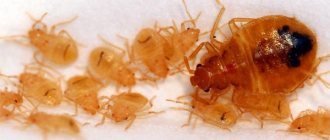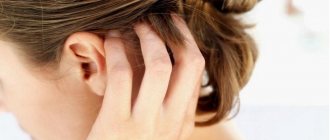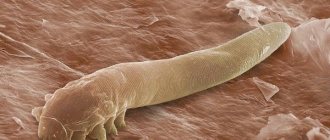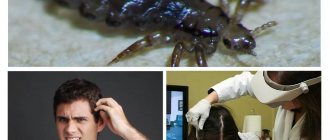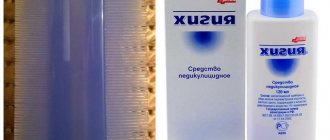Signs of pubic lice
The main symptom of phthiriasis (pubic lice infestation) is itching. It may get worse at night. Because of it, scratches and ulcers form on the skin. It is not always possible to see the insects themselves - they are small in size (no more than 2 mm, and usually much smaller). Lice attach to the hair and appear as dark specks at the base of the hair. When infected with lice pubis, black dots and grains may appear on the underwear. Parasites can live not only in the genital area, but also on the skin in the armpits and other areas of the skin covered with coarse hair (including eyelashes and eyebrows). Pubic lice never live on the scalp, since their limbs are adapted to hold only a triangular cross-section on the hair, while the hair on the head has a round cross-section.
How do you get pubic lice?
Infection can occur in several ways:
- during sex and during close bodily contact with a person already suffering from lice pubis;
- less often, infection through household means through shared bedding, linen or towels is possible;
- There is a minimal risk of infection when visiting public baths, saunas, and swimming pools.
People who frequently change sexual partners are at risk. The likelihood of infection is the same for men and women. Children can also become infected through tactile contact, close hugs, sharing towels or bed with a carrier of pubic lice.
Important! The causes and risks of infection are not related to personal hygiene: cleanliness does not affect the risk of getting lice pubis. Condoms and other barrier contraceptives do not protect against these parasites.
Pubic lice cannot jump or fly, so infection requires close and long enough contact - long enough for the insect to crawl from one person to another.
Video 1. Briefly about pubic lice. Source: blausen.com
Possible methods of transmission of parasites
There are many transmission options, but the leading one is close contact with a sick person. Infection can occur:
- during a hug and a kiss;
- sexual contact;
- while playing together;
- in case of accidental contact of hairstyles, etc.
A child can acquire head parasites as a result of playing together or having close contact with an infected friend. In children's groups they spread instantly. At the same time, the appearance of insects in a child has nothing to do with non-compliance with personal hygiene rules. They appear on both clean and dirty hair.
Parasites also appear through other methods of transmission. Human infection can occur in the following ways:
- adults, as well as nits and nymphs, get onto the hair through shared things - combs, pillows and towels;
- swimming in the same water. Head lice appear in a healthy person after taking a bath in which an infected person had washed before. The insects do not die after falling into the water, but safely move onto the hair of the new host;
- wearing hats together. This method of transmission is especially popular among children. After a child tries on the hat of an infected friend, the appearance of bloodsuckers is inevitable.
What do pubic lice look like?
Pubic lice are dark red or yellow-gray insects. They have six legs, of which the front pair are of increased size. The parasite uses them to cling to hair. The length of the insect usually does not exceed 2 mm. It looks like a dark speck at the very base of the hair. Pubic lice differ from head lice in body structure (it is round, not oblong), and size (it is smaller).
Figure 1. Differences between pubic louse and head louse and body louse. Source: rospotrebnadzor.ru
Lice reproduce by laying pale brown nits (eggs). They may look like thickening of the hair at its very base.
Figure 2. Pubic lice on the skin. Source: Springer Science+Business Media
What do head lice and nits look like on a person’s head?
The head louse is a blood-sucking parasite that feeds on human blood. The habitat (area) is limited. It can live exclusively on hair (hence the name) - this is a mandatory condition. They cannot fly or jump.
The insect looks quite specific, which helps to distinguish it from other parasites. Visually, it is a transparent, wingless bug with six legs. It reaches 3–4 mm in length. Cannot penetrate the skin and live outside the host's body. During illness, nits are also found. They look like white cocoons (eggs) tightly attached to the surface of the hair shaft.
Parasites reproduce quickly, but only under favorable temperature conditions. An adult lives on average about 40 days, and the female begins to lay eggs from the first days if favorable conditions exist. The development cycle of an insect is represented by several stages: egg - emergence of a nymph (larva) - maturation.
How long do lice live outside the head? They cannot live long without a host. Temporary maximum – two days under normal temperature conditions. It is during this time that bloodsuckers can be in search of a new host. When the temperature drops to +10...+12 degrees, the fasting period increases to 10 days.
Body louse and pubic louse can also live and feed on the human body. Their main difference from head lice is the choice of their main habitat.
Symptoms
With phthiriasis, parasites live on hair in the pubic area, perineum, anus, and armpits. Less commonly affected are eyebrows, eyelashes, beard and mustache, and hair-covered skin of the back, chest, and abdomen in men.
When infected, the following symptoms appear:
- frequent itching of the affected areas, which may worsen at night;
- the appearance of ulcers, small blue or bluish spots in the affected area;
- inflammation, skin irritation.
The main symptom is itching, but up to several weeks can pass between infection and its appearance, during which the person will be a carrier of parasites. Ulcers and spots appear on the skin later as a reaction to insect bites or scratching itchy skin. If you suspect pubic pediculosis, you should contact a dermatovenerologist.
Diagnosis of the disease
For diagnosis, examination of the affected area is sufficient. There is no need to take tests or conduct special studies. The examination may be performed using a magnifying glass or examining the hair under a microscope (rarely required). The doctor will examine the areas where itching occurs most often, as well as other areas of the skin that are covered with coarse hair. All patients are examined in the areas of the genitals, anus, armpits, eyebrows, eyelashes. In men, the beard and other areas covered with hair are additionally examined - chest, back, abdomen, legs, arms.
A medical examination is necessary to rule out other skin diseases and allergies and prescribe the correct treatment.
The doctor may additionally refer the patient for examination to exclude sexually transmitted diseases. Pubic lice do not carry such diseases, but infestation with phthiriasis may indicate an increased risk of other sexually transmitted infections.
How to remove parasites: effective means
To treat phthiriasis, external, local drugs are used - they are prescribed by a doctor. There are several effective remedies.
Dimethicone
May be part of a complex of mineral oils, does not contain insecticides. Available as shampoo, spray or lotion. Can be used for children aged three years and older.
Permethrin
An external cream based on this substance is used to treat or prevent head lice. Also comes in shampoo form. The preventive effect can last for a period of two to six weeks.
Boric acid
Medicinal ointments have been developed based on this active ingredient. According to the instructions, the ointment is applied to the scalp and then washed off. The hair is combed out with a comb. The treatment can be repeated daily. Additionally, boric ointment has an antiseptic effect.
In any case, you should consult your doctor before using any drug. It is also important to study the instructions so as not to cause harm by self-medication.
Almost all medications for lice pubis contain permethrin, an insecticidal substance. It destroys pubic lice and nits, paralyzing them and stopping their breathing. Permethrin has a characteristic orange-brown color and a specific odor. Preparations containing this insecticide should be used strictly as prescribed by a doctor and with caution:
- the substance may cause allergies, redness of the skin, increased itching, burning, tingling or tingling;
- when treating phthiriasis and applying products containing permethrin to the skin in the genital area, it is necessary to avoid its contact with the mucous membranes;
- insecticides are not used to kill pubic lice on eyebrows and eyelashes;
- when using insecticidal creams, ointments, shampoos, it is advisable to protect the skin of your hands with disposable gloves or wash your hands thoroughly with soap immediately after using the drug;
- External products based on permethrin are not used to treat head lice in children.
Age restrictions are indicated in the instructions for a specific drug. If a child is infected with phthiriasis, any insecticidal preparations can be used only as prescribed by a doctor.
To reduce the risk of a local reaction, before using a cream, lotion, shampoo or other product containing permethrin, you can apply a small amount to the skin to see if it causes allergies, itching, burning or other unpleasant symptoms.
Folk remedies
Traditional medicine involves the use of a mixture of vegetable oil with kerosene, essential oils, petroleum jelly, and other products that need to be applied to the affected area. This treatment is ineffective: if it leaves at least a few live insects or eggs, pubic lice will continue to multiply. The use of kerosene and other aggressive agents is dangerous: there is a risk of injuring the skin and causing allergies. It is better to use medications prescribed by your doctor. A single use of insecticides is enough to get rid of phthiriasis.
Important! If you are infected with lice pubis, you should not try to treat the disease yourself: some remedies can stimulate the proliferation of pubic lice. Therefore, for diagnosis and treatment you need to contact a dermatovenerologist.
After treating the skin with insecticidal agents, it is necessary to wash clothes, bedding and any other things that may have pubic lice on them. Washing is carried out at a temperature not lower than +50°C.
How to get rid of lice on your head
How to treat pediculosis at home? To get rid of parasites, just go to the nearest pharmacy and purchase one of the suggested remedies. It is important to pay attention to the composition of the drug.
It is important to remember that in addition to head lice, body lice and pubic lice parasitize humans. Therefore, for treatment you need to choose products designed to get rid of a specific type of insect. Thus, body and pubic louse cannot be removed with preparations intended for head insects.
Lotions and concentrates
Products in this category are aqueous or alcoholic insecticidal solutions. They help remove insects by paralyzing the nervous system and subsequent death. Before processing begins, the preparations need to be prepared, but some are sold ready-made.
| Medifox | The product is an insecticide concentrate with the addition of castor oil. Before processing, it is dissolved in water: 8 ml of the drug is taken per 100 ml of liquid. |
| Foxylon (lotion) | The drug is highly toxic and can provoke an allergic reaction. To get rid of bloodsuckers, remove eggs and not get poisoned, you must strictly follow the instructions for use. |
| Medilis-SUPER | An effective pediculosis medicine for lice resistance to the insecticide “permethrin”. Helps quickly remove head lice and remove body lice. |
| Avicen (concentrated solution) | Helps get rid of infection in one treatment. The drug is not recommended in childhood (under 5 years) and while pregnant. |
Lice shampoos
Shampoo treatment is effective for lush and thick hair. It is much easier to remove insects while washing your hair, since the format of the drug ensures that the product gets on the scalp.
Shampoos are distinguished from concentrated solutions by a reduced percentage of aggressive components. Therefore, they can be used to wash the hair of small children.
| Pedilin | The drug helps to quickly remove insects due to the presence of two insecticides - malathion and tetramethrin. The therapeutic effect of treatment during washing will also be obtained if the lice become accustomed to one of the active components. |
| Parasidosis | Treatment with the drug will not be very effective. Most often, re-processing is required. The bottle comes with a comb for combing out head parasites. |
| Hygia | The product gives excellent results and allows you to get rid of insects and nits in one wash. The drug has many contraindications. |
| Shampoo LiceGuard | The medicine contains exclusively natural ingredients. The product helps get rid of nits by softening the shell while washing your hair. Shampoo is used as a preparation that makes it easier to comb out nits. |
Sprays
Spray treatment is especially effective for small colonies of lice. The drugs help get rid of insects without causing side effects. But in childhood they may be prohibited.
| Pediculen Ultra | A remedy for the treatment of pediculosis from a Russian manufacturer. Helps get rid of lice and remove nits. When using, strict adherence to the instructions is necessary. |
Treatment of pediculosis using traditional methods
How to get lice out of your head using home remedies? Traditional treatment is quite specific. The home recipes used are simple and involve the use of inexpensive products. But the faster the hair is cleaned, the less safe the method is.
The most popular folk method of treating the disease is pure kerosene. The substance destroys everything - adults, larvae and nits - but in the process of such folk treatment you can get a big burn. Kerosene is strictly forbidden to be used by children.
Homemade recipe for use: dilute pure kerosene with vegetable oil (proportion 1:6) and apply to hair. Hold until tingling appears.
Fighting head parasites is difficult, but possible. Home treatment will take at least three days, provided that quality medications are used.
There is no specific prevention of the disease. Experts recommend periodically inspecting your baby’s hair and monitoring the appearance of typical symptoms of infection.
Consequences and complications
If lice pubis is not treated, the parasites will continue to multiply. A sick person will infect people in close contact with him. The risks to his health are mainly associated with inflammation, the appearance of ulcers on the skin, and the addition of a secondary infection.
After treatment for several weeks, dead nits may be found on the affected area. This does not require re-treating the skin or hair with the insecticide.
If a pregnant woman becomes infected with phthiriasis, drugs with a minimum concentration of the toxic active substance are chosen during treatment. Pediculosis pubis is not dangerous for newborns; they cannot catch it from their mother. The risks of phthiriasis during pregnancy are associated mainly with the addition of a secondary infection if the disease is accompanied by severe itching and the appearance of ulcers, scratching, and inflammation on the skin.
Prevention of head lice in children
As a rule, already pronounced symptoms become noticeable. The child often scratches his head, is worried and irritated; lice and nits on the hair can be noticed at the first inspection in a well-lit room. However, in order to prevent active reproduction of parasites and prevent infection, it is important to take preventive measures.
Talk to your child on the topic “How to understand that you have lice”, tell us more about these insects, and about when you need to turn to your parents for help. If your son or daughter is too young to explain this to them, examine them yourself during bathing and hygiene procedures.
It is also important to ensure that the child has his own comb, towel and other hygiene items. It is recommended to put the comb in its case. It is recommended to remove hats and scarves in public institutions to avoid contact. You must wear a swimming cap in the pool.
Simple rules of personal hygiene will help prevent the appearance of lice and teach your child to be careful. If you are faced with head lice, getting rid of it will not be difficult. It is important to inform your child’s caregiver or teacher about it, as other parents should also take preventive measures. Pediculosis is not a disease, it does not require quarantine or special measures, all that is required is the awareness of parents and timely treatment of both children and their environment.
Preventive measures
You can reduce the risk of contracting lice pubis by avoiding casual sex. Condoms and other methods of barrier contraception do not protect against phthiriasis. For prevention, it is important to use personal towels, underwear and bed linen, and change them regularly. A good preventative measure is epilation or depilation - hair removal in the bikini area, armpits, and other areas. It improves the quality of personal hygiene, reduces the risk of pubic lice infection, and can be performed for both women and men.
